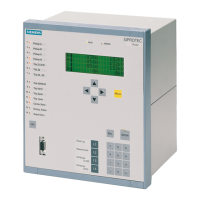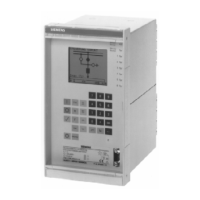2.2 Differential Protection
107
7UT613/63x Manual
C53000-G1176-C160-2
Figure 2-21 Tripping characteristic of the differential protection and fault characteristic
Add-on Restraint
during External
Faults
Saturation of the current transformers caused by high fault currents and/or long
system time constants are uncritical for internal faults (fault in the protected zone),
since the measured value deformation is found in the differential current as well in the
restraint current, to the same extent. The fault characteristic as illustrated in figure
2-21 also applies in principle in this case. Of course, the fundamental wave of the
current must exceed at least the pickup threshold (branch a).
During an external fault which produces a high through-flowing fault current causing
current transformer saturation, a considerable differential current can be simulated,
especially when the degree of saturation is different at the two sides. If the quantities
I
diff
/I
stab
result in an operating point which lies in the trip area of the operating charac-
teristic, trip signal would be the consequence if there were no special measures.
7UT613/63x provides a saturation indicator which detects such phenomena and ini-
tiates add-on restraint (stabilisation) measures. The saturation indicator considers the
dynamic behaviour of the differential and restraint quantity.
The dotted line in figure 2-21 shows the instantaneous currents during an external fault
with transformer saturation on one side.
Immediately after the fault (A), the short-circuit currents rise strongly, causing a corre-
spondingly high restraint current (2 × through-flowing current). At the instant of CT sat-
uration (B), a differential quantity is produced and the restraint quantity is reduced. In
consequence, the operating point I
diff
/I
stab
may move into the tripping area (C).
In contrast, the operating point moves immediately along the fault characteristic (D)
when an internal fault occurs since the restraint (stabilisation) current will barely be
higher than the differential current.
Current transformer saturation during external faults is detected by the high initial re-
straining current which moves the operating point briefly into the add-on restraint area.
The saturation indicator makes its decision within the first quarter cycle after fault in-
ception. When an external fault is detected, the differential protection is blocked for a
selectable time. This blocking is cancelled as soon as the operation point I
diff
/I
stab
is
stationary (i.e. throughout at least one cycle) within the tripping zone near the fault
characteristic (≥ 80 % of the fault characteristic slope). This allows consequential
faults in the protected area to be quickly recognised even after an external fault involv-
ing current transformer saturation.
